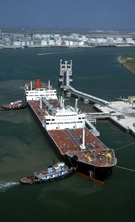This article, which originally appeared in the May 2003 issue of World Bunkering, was written by Joseph N. Hood, U.S. C. G. Licensed Marine Engineer, Former Manager of the Marine & Power Division of Cambridge Viscosity
 Increasingly stringent bunker regulations are forcing Ship Owners and Bunker Suppliers to re-think their understanding of words such as liability and ownership. Following bunker disputes it is not uncommon for a vessel to be held in port until arbitration proceedings determine who is responsible for poor quality bunkers. Bunker Suppliers are reluctant to accept responsibility for the quality of "goods in transit" and with the gathering liability culture in the maritime world it has never been more important for Ship Owners/Operators to identify sub-standard bunker at time of delivery.
Increasingly stringent bunker regulations are forcing Ship Owners and Bunker Suppliers to re-think their understanding of words such as liability and ownership. Following bunker disputes it is not uncommon for a vessel to be held in port until arbitration proceedings determine who is responsible for poor quality bunkers. Bunker Suppliers are reluctant to accept responsibility for the quality of "goods in transit" and with the gathering liability culture in the maritime world it has never been more important for Ship Owners/Operators to identify sub-standard bunker at time of delivery.
To verify bunker quality, vessel operators have traditionally relied on the testing of a sample that can take many days to process. The limitations of the sampling approach are obvious. Is the sample representative? Can it really reflect a nonhomogeneous fluid possibly a million times its size? Is the process reliable and tamper-proof? And is the information available when and where it is needed? Chief Engineer John Duke of the MN TANABATA operated by Pacific Gulf Marine commented, "The issues related to poor quality marine bunkers have forced ship owners to take advantage of technologies that provide more accurate results while reducing response time".
There are a number of properties that determine the quality of marine fuels, however the key parameter is viscosity. Each grade of bunkers is quoted with a specific viscosity tested at 50° Celsius. Irrespective of whether a load of bunker is refinery produced or blended at a shore facility it is expected to be within a few (cSt) Centistokes of its specification. In reality bunker loads can vary considerably from specification and are seldom homogeneous. The causes of off-spec bunkers vary from human error and corruption to instability of blend inherent in the original product. In many cases the supplier is as much a victim of the system as the end-user.
The Cambridge VISCOpro 2000 bunker monitor is endorsed by J.J. Sietas KG Schiffswerft shipyard of Hamburg for all new-builds that require a bunker monitoring system. "With the rising cost and declining quality of fuel oil, smart buyers are now demanding more and more quality verification. The bunker monitor can assure every litre in every ton delivered," says Ernst Thone, Energy Consultant of Martechnic GmbH.
Electro-Motive Diesel uses Cambridge Viscosity Sensors on Their Most Advanced Production Engines
Known for innovation in viscosity measurement and control, Cambridge Viscosity specializes in the industry's most accurate, reliable, and easy-to-use viscometers for research laboratories and process environments.
Cambridge Viscosity, Inc.
50 Redfield St, Suite 204
Boston, MA 02122 USA
781 393-6500
Email: Sales@CambridgeViscosity.com